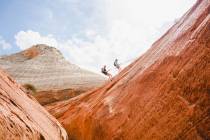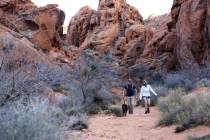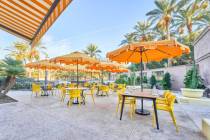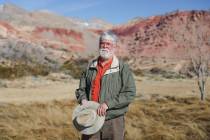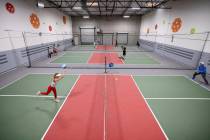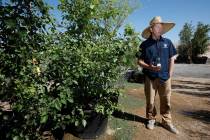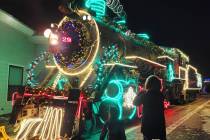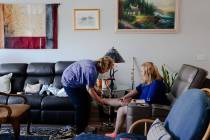Stalled buildings: Second chances in the city of reinvention
Lisa Chang has spent a decade looking at an unfinished casino. The Fontainebleau, which was originally supposed to open in 2008, rises 67 stories above the Strip, its silver-blue glass punctuated by plywood where windows should be. Chang lives in a nearby high-rise, and each morning she steps out onto her balcony and looks at the hulking building — the second tallest in the state — that’s been blocking her view since she bought her home in 2011.
“You know when you get a wart somewhere and it doesn’t go away?” Chang says. “And after a while, you just sort of work around it? And you’re like, OK, that’s just a part of me now. That’s how I feel about it.”
The story of the Fontainebleau is a story of the perilous gap between hype and execution. This is also the story of Las Vegas: a place that appears on lists of best cities for a fresh start, and a place where thousands of people end up living in storm tunnels.
Las Vegas was my new beginning in 2015. While so many of my friends had spent their 20s doing internships that turned into cushy jobs, I’d spent mine moving from state to state, taking short-term jobs, making short-term friends. But I wanted to establish myself somewhere. I wanted to be a writer. Looking at Las Vegas from the crest of the highway as I arrived, it appeared as a silent, hazy outline of an uncertain future. This wasn’t my first time starting over, but it felt different — don’t we always say that, though? Anything can happen here, I thought, not knowing if “anything” was possibility or disaster.
By that point, the Fontainebleau had already had several fresh starts. Originally announced in 2005 by Jeffrey Soffer, chairman and CEO of Fontainebleau Development, on the site of the former El Rancho hotel-casino, it was conceived as a 25-acre resort with 3,780 hotel rooms/condos, a casino, meeting space, restaurants, a pool and retail shops. Construction was supposed to begin in 2006 but didn’t get underway until 2007. Two years later, when it was 75 percent complete, the project lost its funding. In 2010, it was purchased out of bankruptcy for $150 million by Carl Icahn, who sold the building’s escalators and construction cranes instead of finishing it. In 2017, Icahn offloaded the still-empty property for $600 million to Steve Witkoff, who rebranded it as The Drew in honor of his son, who died of an opioid overdose.
“The news is out,” the resort’s Twitter account posted on Feb. 12, 2018, before never tweeting again. “Hello from The Drew.” As quickly as it was announced, The Drew’s financing dried up. The building remained vacant.
I felt equally stalled. After three years of living in Las Vegas, my dreams of becoming a writer had given way to a copywriting job for a self-storage company. Each day I typed up blog posts like “10 Reasons Why You’re Storing Your Mattress Wrong” and wondered if I’d ever write a novel. At the end of the day, I’d go for a walk and look at the Fountainebleau. The big, dark silhouette on the Strip, the shadow haunting the brightest city on Earth.
Marking What Could Have Been
To single out the Fountainebleau was not entirely fair. On the opposite end of the Strip, two abandoned steel towers marked the site of the SkyVue, once envisioned as the largest observation wheel in the Western Hemisphere. In 2011, two competing wheels, the SkyVue and the High Roller, were announced. The former — the one you’ll never ride because it doesn’t exist — was going to be 500 feet tall with 50,000 square feet of LED on each side (these would have been the largest LED displays in the world), plus retail, dining, entertainment and convention space. Developer Howard Bulloch called it “the gateway to the Strip,” and promised it would “forever change the landscape of America’s playground.” On March 1, 2012, more than 100 trucks appeared at the site to pour the concrete for the foundation. Bulloch boasted of a July 4, 2013, opening. Meanwhile, construction on the 550-foot-tall High Roller at the center of the Strip had been going on for a month. I remember thinking, two observation wheels on the same street seems a bit much. But in Vegas, a bit much is usually the right amount. Maybe it’ll work out, I thought. It didn’t. By November 2012, the SkyVue hadn’t made nearly as much progress as the High Roller and had only $2,500 in investment funds left. The Twitter account @SkyVueLasVegas, which still exists and has 412 followers, continued to cheerfully tweet Vegas well-wishes and travel tips (“What’s your favorite thing to do in #winter weather?”). By the time the High Roller opened in March 2014, the other wheel was forgotten, the site abandoned, two massive metal pillars marking what could have been.
Approximately 1.5 miles north of these remnants, there’s a paved-over place on the Strip that bears no memory of another stalled project. In 2008, the Harmon, meant to be a 49-story boutique hotel with luxury residences, had constructed 26 floors when an engineer discovered improperly installed rebar. Hoping to continue anyway, the developers reduced the project to 28 floors and scrapped the residential element (unfortunate news for the many buyers already in place). The narrow building with its curved edges gleamed mythically on Las Vegas Boulevard, as fantastical as the mermaid scales its turquoise and sapphire windows resembled. The center of Las Vegas is just around the corner, a banner on its side proclaimed. Despite the alarming news of the improperly installed rebar, which holds the weight of the building, the project forged ahead in typically optimistic Las Vegas fashion. But just as there is a gap between hype and execution, there is an invisible line between optimism and foolhardiness. The Harmon proved itself the latter when a 2011 engineering report revealed damning news: The building would likely collapse in the event of an earthquake. Even worse, it couldn’t be imploded because of how close it was to other buildings. From 2014 through 2015, the team that had conceived the Harmon had to endure the humiliation of seeing it taken apart floor by floor. It cost $275 million to build and $173 million to deconstruct.
The Building Disintegrated
It’s hard to talk about the slow demolition of the Harmon without thinking about how quickly we prefer to destroy things in this city. To date, there have been 15 implosions in Las Vegas. They take seconds — that’s the part that stays with you, how fast an entire building can be turned to nothing. The most recently imploded casino, the Riviera, which opened in 1955, came down in two implosions in 2016. The first took place on June 14 with great fanfare, as these things often do. The Las Vegas Convention and Visitors Authority held a party with showgirls, fireworks and tables with white linen. When the resort’s Monaco Tower came down, people clapped and toasted with champagne.
I was present for the second one, the Monte Carlo tower. It’s the only Las Vegas implosion I’ve ever seen. At 1 a.m., I had a blue Hawaiian cocktail and a plate of French toast at the Peppermill, and then I went out into the street where a small crowd had gathered. The tower was not illuminated. There were no celebrity guests. No live music. No countdown. We stood quietly, looking up, and at 2:30 a.m., the booming of dynamite punctured the hot August air and the building curtsied and gracefully disintegrated into a cloud of dust. Watching it made me feel afraid in a primal, instinctive way — like seeing a stormy sky turn green or a chandelier tremble at the start of an earthquake. That is to say, it looked and felt like a natural disaster. It also made me sad. Some of the resort’s former employees stood crying in the street. They’d come to say goodbye. Still, when I got home that night, a perverse part of me hungered for another implosion. I’m not alone in that. If you search “Las Vegas implosion” online, Google will tell you that people are also asking, “When is the next Las Vegas implosion?”
Here is where you might think I’m going to say that an implosion is proof Las Vegas has no reverence for its history. But an implosion can also mean the start of something new, like Resorts World, which opened in 2021 on the site of the imploded Stardust. For years, Resorts World seemed like another cautionary tale of stalled ambition. After the Stardust was imploded in 2007, a different resort — the Echelon — was slated to open in 2010, but construction was suspended in 2008 because of the recession and then canceled entirely. It seemed like the dusty footprint of the Stardust would become another vacant lot. But in 2013, Genting Group bought it and began building Resorts World. The groundbreaking ceremony took place just 27 hours after the Riviera closed for good on May 5, 2015. There were Chinese lion dancers and thunder drummers. There was a 2016 opening date on the horizon. And then … there was nothing. Now the resort would open in 2017. Now in 2018. No, 2020. I believed what the history of so many failed Las Vegas projects had taught me: It would never happen. But then the glossy, burnt-red building began to take shape. And as it did, my own life rearranged. I quit the copywriting job, started writing things I wanted to write. Short stories. A novel. I applied to graduate school and got in. And before I knew it I was standing beneath the porte-cochère at Resorts World in a cocktail dress on opening night, waiting to be let inside. And then I was on the pool deck, watching the fireworks, seeing the first guests check in, and crying — actually crying — because it was the first Strip property to open in more than a decade and I was a part of that. We all were.
And here is the twist in the narrative, the part in the story where we return to the Fontainebleau.
On Nov. 9, 2021, the Fontainebleau held its second groundbreaking, nearly 15 years after the first. And in a beautiful bit of symmetry, the original owner, Jeffrey Soffer, had taken the reins again. “It’s kind of a crazy story,” Soffer was quoted as saying in a news release. “But I’m back.” The bones of the building were in good shape, he said. The resort is scheduled to open in 2023 ahead of the Super Bowl, which will be held for the first time ever in Las Vegas in 2024.
I’ll admit it: When I saw the news in November I didn’t believe it. I tweeted “hahahahahahahahahahahahaha” and moved on.
“I’ll believe it when I see it,” Lisa Chang told me from her high-rise.
But in December, illuminated signage appeared on the tower — a flicker of life on a piece of Las Vegas so many of us had presumed dead. With those lights, a shift occurred. Who will I be, I began to wonder, when the doors are open?
Anything can happen here, I’d told myself on that highway in 2015. But it hadn’t been a binary — possibility or disaster. Anything meant anything.
People are wrong when they say Las Vegas has no respect for its past. What they are missing is that it is something else entirely: a city with deep reverence for its future. This is why we monitor the changing outline of the Strip, why we believe just a little bit that the construction cranes will return to finish stalled projects. This is why we moved here in the first place: Because sometimes when you try to reinvent yourself, it works out.
The gap between hype and execution hasn’t closed yet, but it is narrowing. What would that be like, I asked Lisa Chang, to step inside the Fontainebleau after staring at its lifeless scaffolding for so long?
“If it was finished,” she said, “it would be beautiful.”



